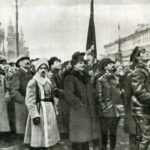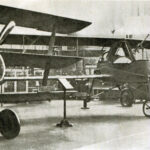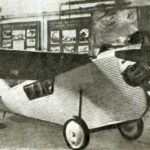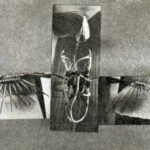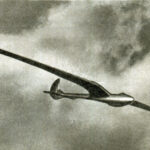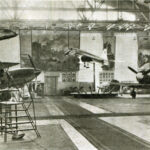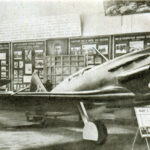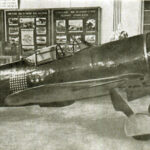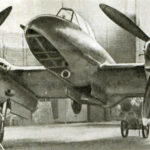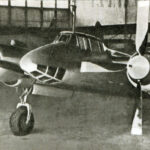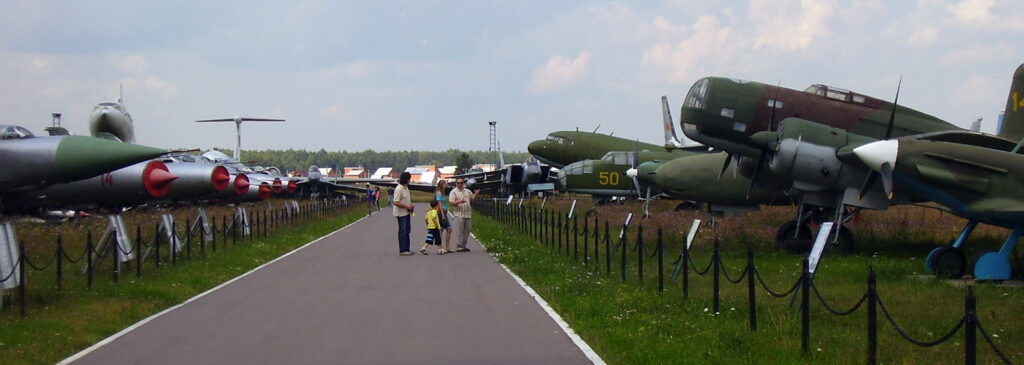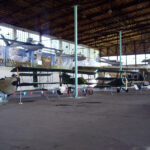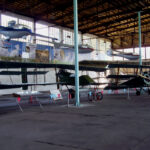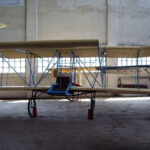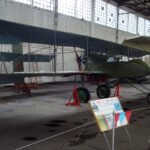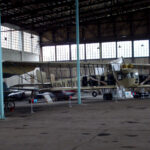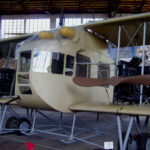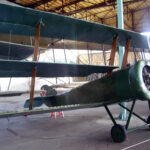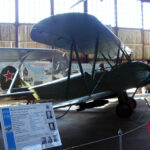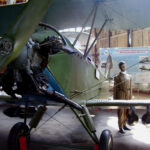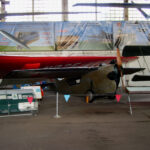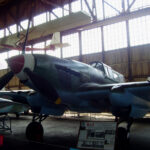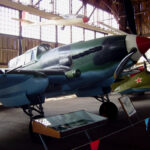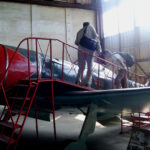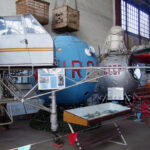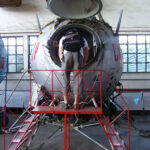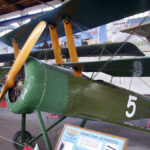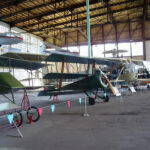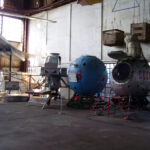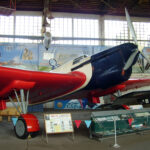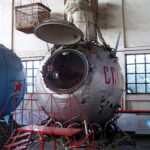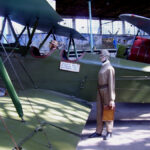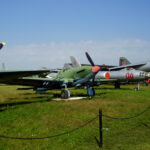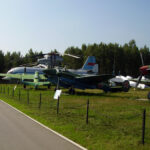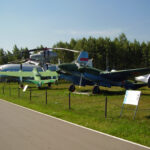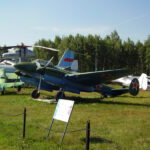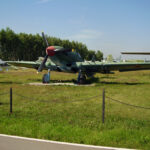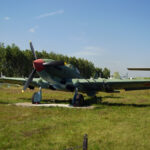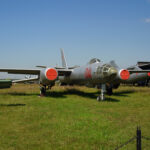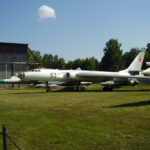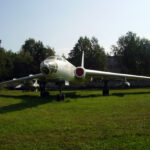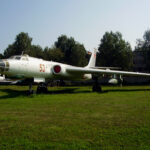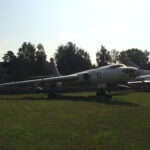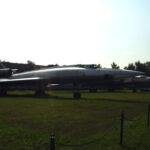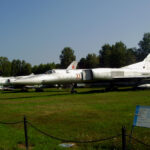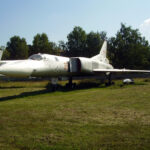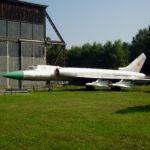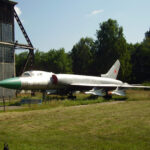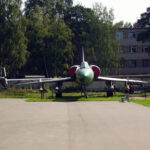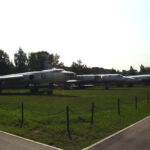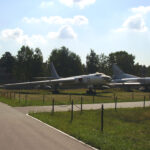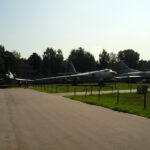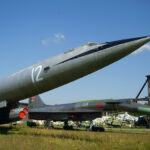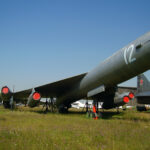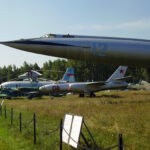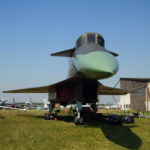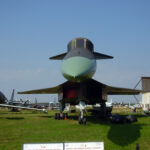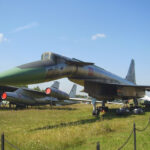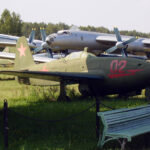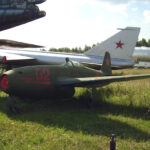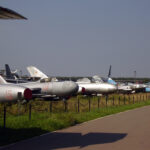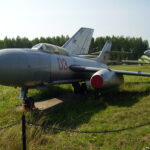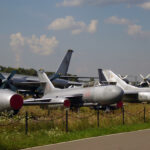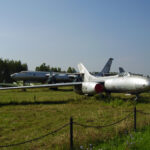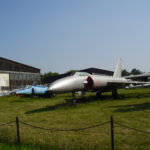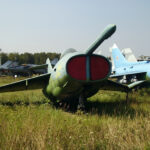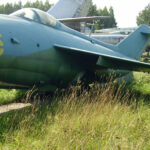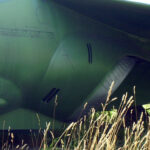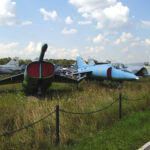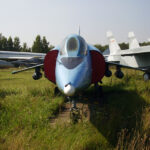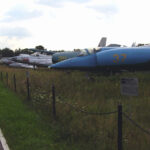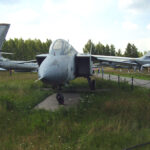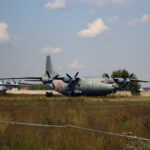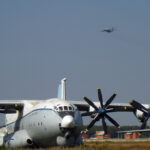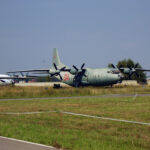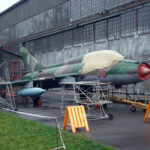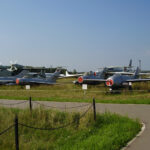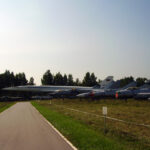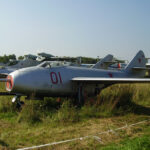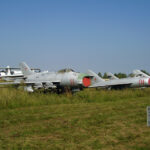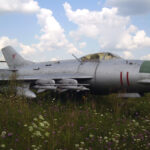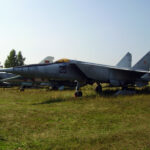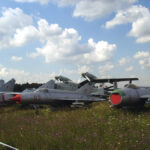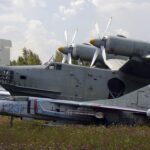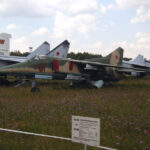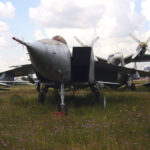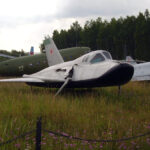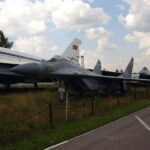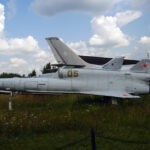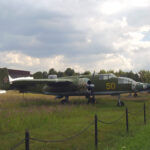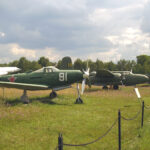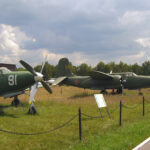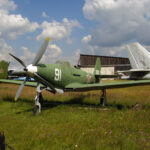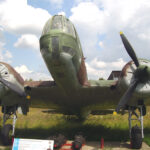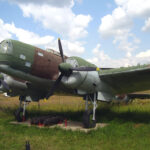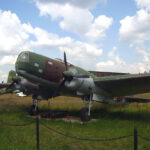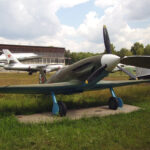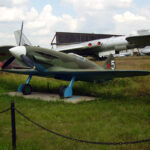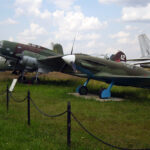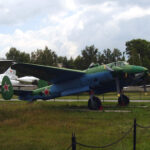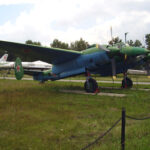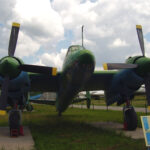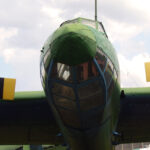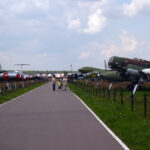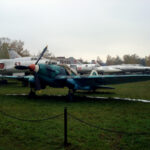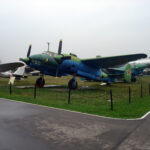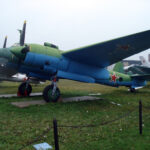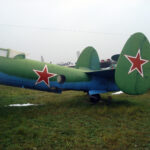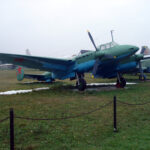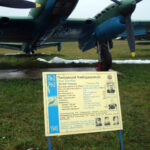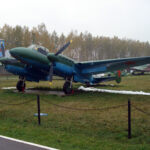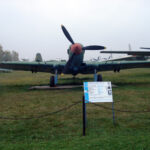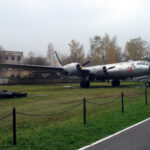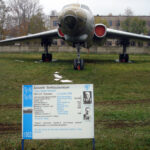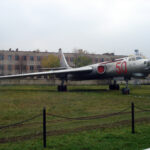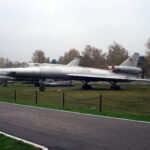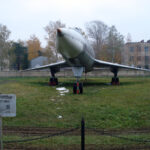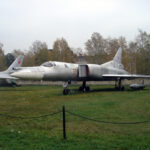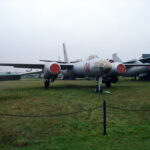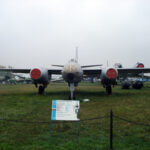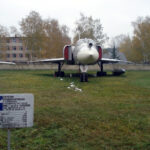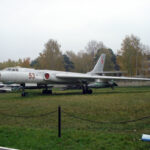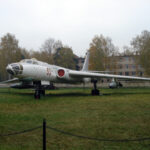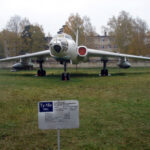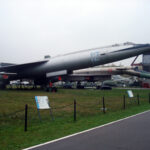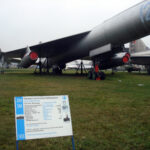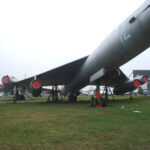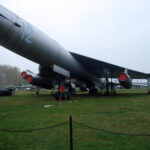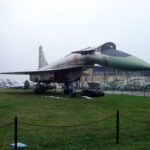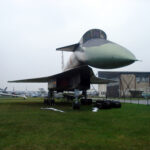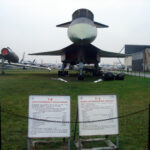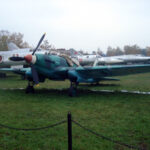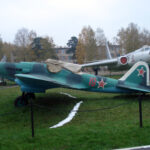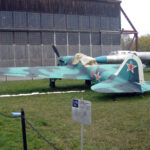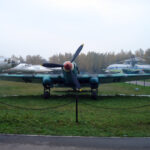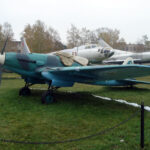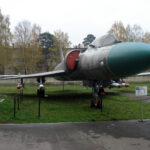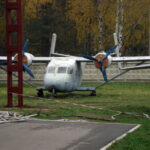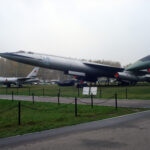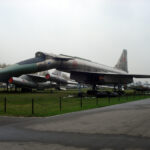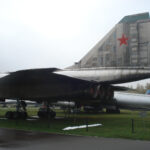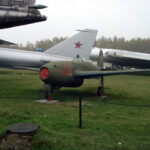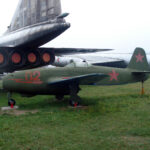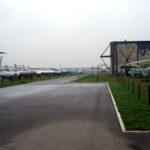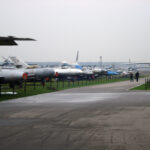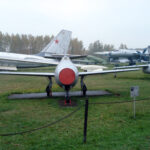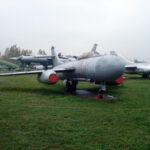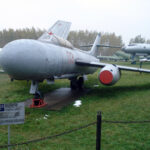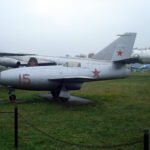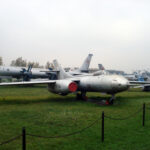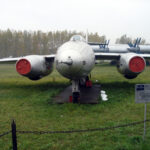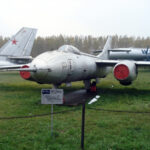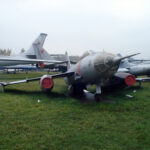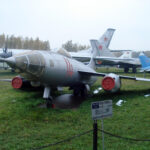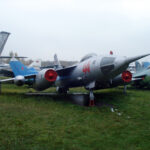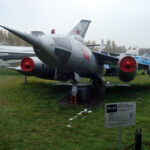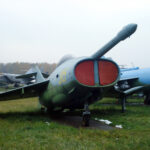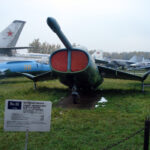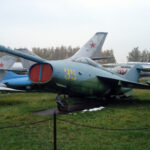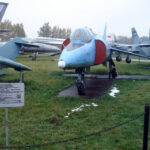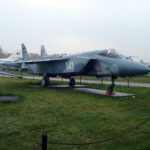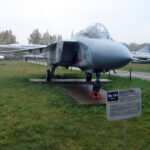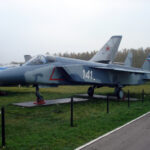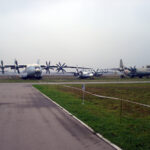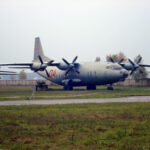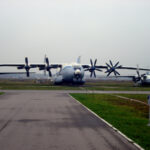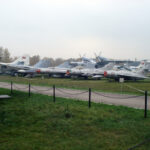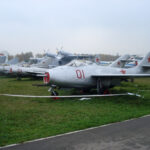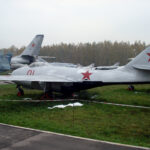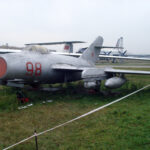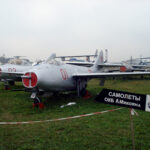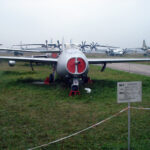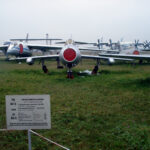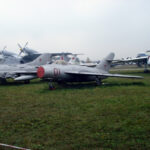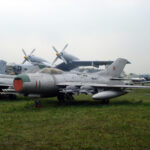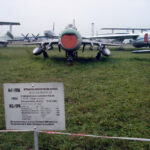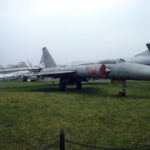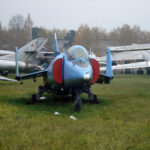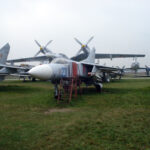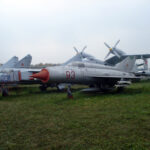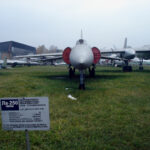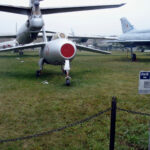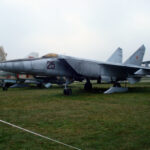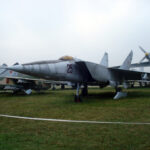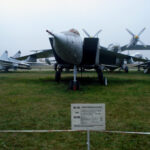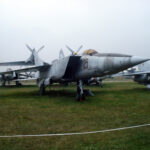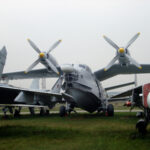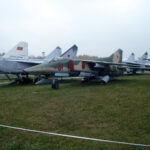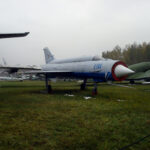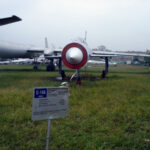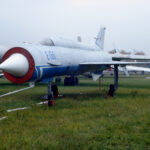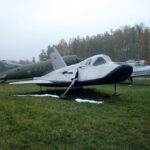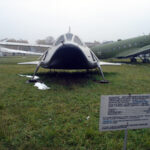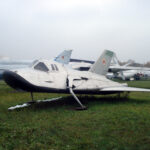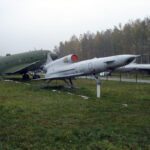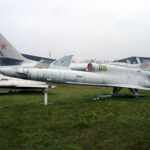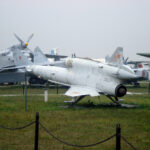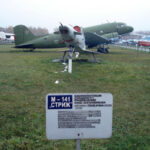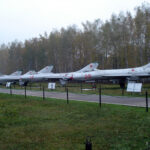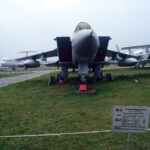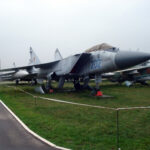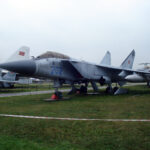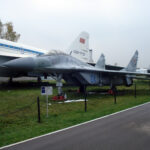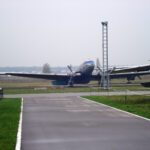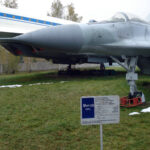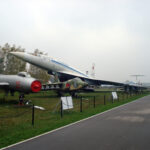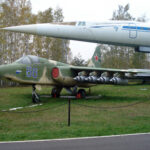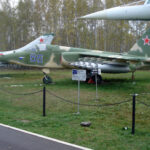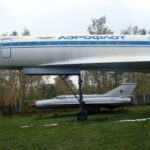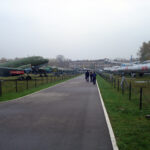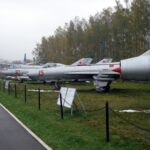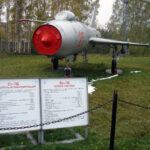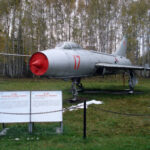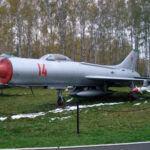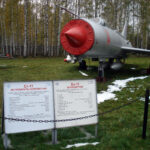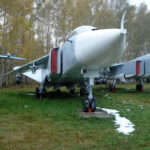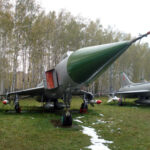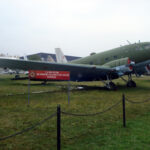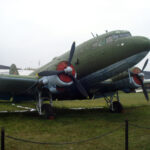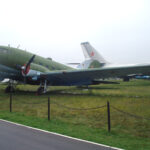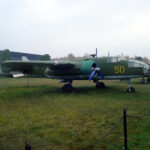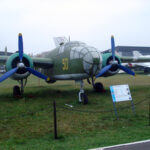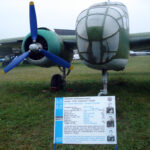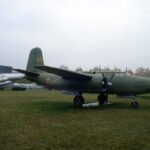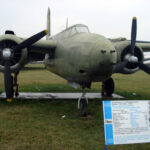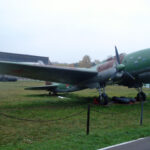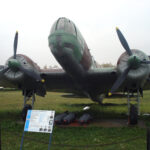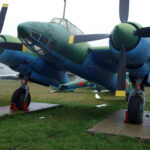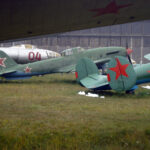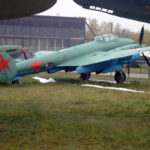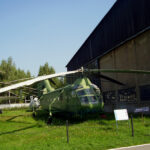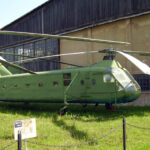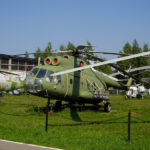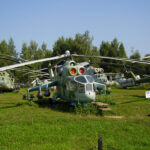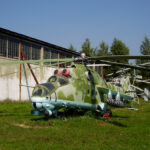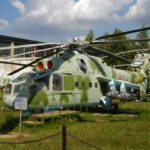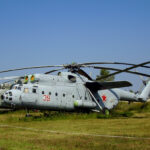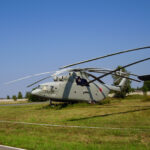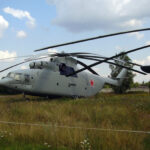The National Museum of Aviation and Cosmonautics (Le Bourget near Paris) has a large collection of Soviet aircraft and spacecraft located in several pavilions and on an open airfield area. Friends of the Museum in Le Bourget prepared and below we place a guide to Soviet aircraft, uniforms and insignia of Soviet pilots, according to our own archives. The historical information about the collection of the aviation museum in Monino is especially interesting because after the collapse of the USSR there was an “accidental” fire and many unique personal items burned down, and the whole building was destroyed. After the liquidation of the Air Force Academy in Monino, there was an attempt to transfer the Museum’s collection to another place – Patriot Park near Moscow of the Ministry of Defense. Some of the exhibits were successfully transported, while the other part of the unique large exhibits was damaged. After the conflict between the Ministry of Culture and the Ministry of Defense, the Museum was closed for a long time, but then it was decided to keep it in Monino. For this, a new pavilion was built and a major reorganization was carried out. The museum was created as a practical guide for the study of aircraft for students of the Gagarin Air Force Academy, as well as for design engineers and a special category of citizens of the USSR. According to the military tradition, former teachers of the Academy and Veterans of the Air Force worked as tour guides in the Museum. After the reorganization, these traditions were violated, but the museum became more in line with modern times.
Air Force Museum Monino tour Guide
Version 1981, USSR Ministry of Defense.
The Museum of the Air Force was founded in 1958 and is the only aviation museum in our country, the collection of which is based on unique samples of aviation equipment. Currently, it has collected more than 100 full-scale aircraft and helicopters, over 200 models. Aircraft engines, aircraft equipment, weapons, radio equipment and other equipment are widely represented. A large number of authentic historical materials, documents and relics, works of art are exhibited. The exposition of the museum reveals the history of the development of domestic aviation from the world’s first aircraft by A.F. Mozhaysky* to modern aircraft, shows the heroism of Soviet pilots.
- Vladimir Lenin and Yakov Sverdlov on Red Square, air parade 1918
- WW1 triplane “Sopwith” (left) and biplane “Voisin” (photo 1)
- Soviet aircraft ANT-2 Tupolev (photo 2)
- Aircraft “Makholet” (“Letatlin”), N3
- Glider “Joseph Unshlikht” (“Seagull”) N4
- Hall N6, in the center is a model of the Tu-144 aircraft (5)
- WW2 Fighter MiG-3 OKB A.I. Mikoyan (1940), N6
- WW2 Fighter La-7 Design Bureau Lavochkin (1943) of the famous pilot Kozhedub, N7
- World War 2 Bomber Pe-2 (N8)
- Best WW2 bomber Tu-2 A.N. Tupolev (n9)
Photo gallery: On the day of the first anniversary of the Great October Revolution (1918), V. I. Lenin and Y. M. Sverdlov** among the workers are watching the flight of an aircraft over Red Square.
Photo 1: Aircraft of the period of the First World War and the Civil War: the Sopwith triplane (left) and the Voisin biplane, serially built in our country.
N2: The first Soviet all-metal aircraft ANT-2 designed by A. N. Tupolev (1924).
N3: Aircraft “Makholet” (“Letatlin”) designed by V.E. Taglin (1933).
4: Glider “Joseph Unshlikht” (“The Seagull”) designed by P.A. Ivansen with high lift-to-drag ratio and high wing aspect ratio (1934).
5: A fragment of the exposition of the 6th hall, in the center there is a working model of the Tu-144 aircraft designed by OKB A.N. Tupolev.
6: Fighter MiG-3 OKB A.I. Mikoyan (1940), which was successfully used in the first period of the Great Patriotic War.
7: Fighter La-7 of Lavochkin Design Bureau (1943), one of the best fighters of the Great Patriotic War. On this plane, the famous ace I.N. Kozhedub destroyed 17 enemy aircraft, bringing the number of the downed enemy aircraft to 62.
8: The main front-line dive bomber Pe-2 designed by V.M. Petlyakov (1940). It was successfully used throughout the Great Patriotic War.
9: Tu-2 front-line bomber designed by OKB A.N. Tupolev (1942). One of the best aircraft of World War II.
Guide Version 1994, Monino, Russia.
In November 1993, the Air Force Museum celebrated its 35th anniversary. Having started its biography as a museum-exhibition of aviation equipment, over the past relatively short period of time it has turned into one of the largest museums of this type not only in our country, but also abroad. In December 1992, the museum was admitted to the International Organization of Museums (ICOM). Today, the museum’s funds include 38 thousand items, of which a little over six thousand are on display. Compared to well-known museums, whose collections consist of hundreds of thousands of items, the above figures are not impressive in themselves. However, the basis of the exposition of the Air Force Museum is 126 authentic aircraft (there are more than 150 of them in the museum’s funds). Among them are 90 aircraft, 16 helicopters and 14 gliders. To see such a number of aircraft assembled together today is possible only in two or three museums in the world.
Most of the aircraft are placed in an open area and in two hangars. A view of the museum’s outdoor area is shown on the back cover of the brochure. There are planes and helicopters for various purposes (fighters, bombers, attack aircraft, civil aviation aircraft, etc.). The museum has many unique aircraft, such as the Voisin biplane or the Sopwith triplane, which have been preserved since the now distant First World War and the Russian Civil War. The first aircraft that became museum exhibits were Po-2, Tu-4, Yak-7, etc. There were 11 aircraft in total.
Different paths led certain planes to the museum parking lot. Some, having worked for many years in the sky, went on a “well-deserved rest”. At the same time, for some of them, the last flight was a flight to the museum airfield. The flying life of others, usually experimental aircraft, was short. Made in a single or several copies, they helped solve complex scientific problems, or achieve record speed, altitude, payload and flight range. Several museum aircraft (SB, Il-2, Pe-2, R-5) have been recreated, sometimes literally from wreckage discovered by chance or as a result of purposeful search work. In this regard, the history of the Il-2 aircraft with serial number 301060 is noteworthy. In December 1942, pilot-sergeant Fedotov M.A., returning from a combat mission, was attacked by enemy German fighters, was shot down and forced to land the aircraft on the fuselage in the “Niviy Mokh” swamp » near the city of Novgorod. The pilot himself was not injured and returned to his unit. He successfully fought until the end of the Second World War, ending it in Berlin. The plane lay in the swamp for over 30 years. The little that remained of it, and this armored hull, parts of the wing and stabilizer, and other metal units, were literally torn out of the quagmire by a powerful Mi-10k helicopter and transferred to the nearby airfield of the Novgorod flying club. During the search, another Il-2 attack aircraft was discovered. Restoration work was carried out at the enterprise named after S. V. Ilyushin. One aircraft was installed on the territory of the Design Bureau, becoming a monument to this legendary “flying tank”.
There are two inscriptions on the monument. One is a dedication: “To the heroes of the front and rear of 1941-1945. Your feat is immortal.
Another – briefly reveals the history of this aircraft.
The museum IL-2, before taking its place in the hangar, starred in two films: “A Particularly Important Task” and “You Must Live.” The engine and braking system of this aircraft were restored to working condition. He independently “steered”, although it was not possible for him to get off the ground. Such a difficult task was not set.
A lot can be said about most of the aircraft on display at the museum. For example, in one of the halls, the La-7 fighter is exhibited, on which our illustrious three-time Hero of the Soviet Union I.N. Kozhedub ended the Second World War. On this plane, he won 17 victories.
In addition to aircraft, the museum has a rich collection of aircraft engines, guided and unguided weapons, means of communication and crew rescue, awards and some personal belongings of famous aviation commanders * and Heroes of the Soviet Union, books and films on aviation topics, relics and other materials. Taken together, the aircraft and other exhibits presented in halls, hangars and outdoor areas allow us to trace the history of the development of aviation in our country in chronological order from its inception to the present day.
The history of aviation development takes a relatively short period of time, equal to the life span of no more than two human generations. However, the progress made in the development of aviation science and technology is impressive. At the same time, our compatriots made an outstanding contribution to the development of all areas of aviation science and the practice of aircraft construction. Suffice it to say that the priority in the creation of the first aircraft belongs to Alexander Mozhaisky. A whole series of our scientists, including Dmitry Mendeleev, Sergei Chaplygin, Nikolai Zhukovsky and many of his students, laid the theoretical foundations of aviation. The first knowledge of aviation science appeared within the walls of the Moscow Higher Technical School, where the aeronautics society worked under the guidance of Professor N. Zhukovsky. This association included students of the Moscow Higher Technical School – later famous figures of domestic aviation – Tupolev, Arkhangelsky, Vetchinkin, Stechkin.
Today Russia is one of the leading aviation powers. And it became such (we hope and will remain in the future, despite its difficult current economic situation) thanks to the heroic efforts of older generations. Namely heroic efforts, if we recall the most difficult conditions in which our people had to create the scientific and production base of our domestic aviation.
One can evaluate the Soviet period in the life of our society in different ways, but one cannot but admit that the modern aviation industry, as a set of design teams, factories, research and other institutions, was mainly created during this period. Until 1917, only 5600 aircraft were produced in Russia, while the aviation industry of France, England, Germany, Italy and the USA only during the years of the 1st World War produced 180.8 thousand aircraft and 240.1 thousand aircraft engines. And yet, in the pre-revolutionary years, many aircraft of original designs were built in Russia, on which a number of world records were set. A special place in the development of domestic aviation belongs to aircraft produced by the aviation department of the Russian-Baltic Carriage Works in St. Petersburg. The flying boats of D. Grigorovich M-5 and M-9 became at that time a major technical achievement and served the Russian Navy well. There were no seaplanes abroad during the First World War.
The Russians wrote many glorious pages in the history of aviation. Let’s remember only the pilot Pyotr Nesterov. His name is known to aviators all over the world, as well as one of the complex aerobatics figures – Nesterov’s loop. This man lived a short but amazingly bright life, ending it with the world’s first ramming attack by an enemy aircraft. Military pilots of Russia have always been distinguished by a high sense of military duty, which was especially pronounced during the Great Patriotic War. Here is one example.
The operational report of the Sovinformburo for July 13, 1943, noting the successful offensive of our troops on the Orel-Kursk and Belgorod directions, reported: “… Pilots of the N-th Guards Unit shot down 156 German aircraft in three days of fighting. Hero of the Soviet Union Guard Lieutenant Novikov shot down 5 enemy planes. Guard pilot Lieutenant Gorovets met in the air with a group of German aircraft. Entering into battle with them, Comrade Gorovets shot down 9 German bombers.
Nine downed aircraft in one battle! The history of air battles does not know such a feat.
The profession of a pilot has always been considered one of the most honorable in our country. According to a survey conducted at one time by one of the central newspapers, military pilots in a long list of professions proposed for assessing the prestige of professions took second place, second only to nuclear physicists. The circumstances of modern life in the country have significantly changed the views and aspirations of young people. The majority of young people are now oriented towards areas of activity that are very far from aviation. This applies to many other formerly revered professions.
In this regard, along with the main activity – the acquisition and preservation of funds, research and educational activities, museum staff pay no less attention to the development of patriotic feelings of young people on the example of military and labor exploits of their fathers and grandfathers. Most of the museum’s researchers and guides are former pilots and navigators with extensive flight experience.
Every year, the Museum is visited by up to 200 thousand people, of which about a sixth are from near and far abroad.
There is no such visitor who would not be excited by what he saw and heard here. Of the large number of reviews left by visitors to the museum of various positions, we will cite only a few.
“Wonderful museum! What rare aircraft! And if I was not a pilot, then after visiting your museum I would definitely become one. Our guide really has something to be proud of. Bravo to his enthusiasm and many thanks for showing.”
Colonel of the French Air Force Rather.
“Delighted by the collection of the Air Force of the brave people. Thank you.”
Monino Air Force Museum catalog of exhibits
It is impossible to compile an accurate and complete catalog of the museum, since the list of exhibits has changed and is changing for the following reasons. First there was a fire and one building of the museum burned down, where there were personal belongings, uniforms, awards and documents of famous Soviet pilots and commanders during the Second World War and the Cold War. Whether it was a deliberate arson to hide the theft or spontaneous combustion is still unknown. Next came major “reorganizations and optimizations” in the Russian army. The Ministry of Defense decided to move the museum exhibits from Monino to Patriot Park on Kubinka, located in the opposite place of the Moscow region. Some of the military equipment had already been moved, but it turned out that when transporting large oversized aircraft, breakdowns and damage to exhibits occur. Due to damage to unique exhibits, the Ministry of Culture banned the movement of large aircraft. The museum was closed for a long time and awaited its fate from officials of the Ministry of Culture and Defense. Two options for moving to Poklonnaya Gora* and Khodynka Field** were considered. Both of these places have aviation museums that are easily accessible to tourists, unlike Monino. But the winning option was to leave everything in place and build new premises and exhibitions in accordance with modern museum requirements. The museum in Monino became a branch of the Army Museum, which itself is a branch of Patriot Park in Kubinka. The dissolution of the two air force academies and the transfer of the flight training center from Moscow to Voronezh also provided a collection of aircraft that were used in training. For these reasons, we provide a step-by-step, incomplete list of all the museum’s exhibits since its opening in 1958, especially the most famous.
Air Force Museum Monino famous exhibits list
Tu-4 – Tupolev long-range bomber, exhibit of the N1 museum since 1958.
Pe-2 – dive bomber of World War II, received in July 1959.
DB-3, Il-2, I-15 bis, R-63 Kingcobra, A-20G Boston, restored from elements of crashed aircraft.
The First World War and the Red Army of Comrade Leon Trotsky
“Ilya Muromets” is an exact copy of the huge Russian aircraft of the First World War, designed by the world famous aircraft designer Igor Sikorsky.
Voisin is an original, a reconnaissance biplane.
Sopwith – triplane fighter.
Rare archival views of the hangar in 2006-2007 before the reorganization, the construction of a new building and the movement of exhibits of the Second World War (author’s archive).
- Hangar of the First World War, interwar period and spacecraft )2006 archive)
- Another type of biplane and triplane
- The main training aircraft of pre-revolutionary Russia Farman IV, France 1909.
- WW1 Scout Voisin, France (2007 photo)
- Heavy unusual Ilya Muromets by Igor Sikorsky (archive 2007)
- Ilya Muromets cockpit and engines
- Comrade Trotsky’s Red Army triplane (2006 archive)
- Po-2 (U-2) Nikolay Polikarpov
- Po-2 airplane cockpit and pilot in WW2 uniform
- All-metal ANT-2 plane
- Il-2 flying tank, WW2 armored attack aircraft
- IL-2 armored attack aircraft from the other side
- Monino Central Air Force Museum spacecraft
- ANT-25, non-stop flight Moscow-USA
- Turbolet
The first Soviet aircraft ANT-2 is the first Soviet all-metal aircraft from 1924.
SB – high-speed bomber 1934, an exact authentic replica, made by the design bureau according to original drawings and original materials.
ANT-25 – the plane of Chkalov’s flight from Moscow to the USA in 1937 (also a replica from original materials).
Second World War the old hall and the new building.
I-15 is a super maneuverable biplane fighter.
I-16 is a high-speed monoplane of Nikolai Polikarpov, the king of fighters.
U-2 (Po-2) night bomber of World War II
R-5 reconnaissance and light bomber, Polikarpov biplane.
IL-2 legendary attack aircraft, flying tank 1942, restored from the wreckage.
Il-10 improved attack aircraft 1944 with a powerful engine.
MiG-3 fighter (full-size mock-up) which Pokryshkin flew.
Yak-9 fighter Alexander Yakovleva, enemy of the German Messerschmitts and Fokkewulfs
La-7 fighter of the Soviet ace Ivan Kozhedub.
DB-3 bomber
Pe-2 dive bomber
Tu-2 with heavy aerial bombs from the end of the war.
Li-2 transport for cargo and troops.
Lend-Lease and aircraft of the US and British allies.
A-20 Boston – bomber,
B-25 Mitchell – bomber,
R-63 Kingcobra.
These aircraft are recovered from remains found on the battlefields of World War II.
Post-war period and Cold War
MiG-9 first jet fighter flight 1946.
MiG-15 and La-15 are the first production fighters with swept wings.
Yak-18 training for flying clubs and group aerobatics.
MiG-21 with a delta wing, a massive supersonic aircraft, a participant in local wars in Vietnam and the Middle East, in Afghanistan.
MiG-23 with variable wing for short runways.
The MiG-25 looks like a clumsy suitcase with a powerful engine.
E-166 (aka E-152) – high-speed for international sports.
- 2006 Archive, Ik-10M (WW2)
- WW2 aircraft Pe-2
- WW2 section (Pe-2 photo)
- More photo of Pe-2
- World War 2 IL-10M
- One more photo of IL-10M (WW2)
- Soviet IL-28 first jet bomber
- Tu-16
- Tupolev Tu-16 missile carrier
- Tupolev Tu-16 missile carrier
- Long-range bomber Tu-16 missile carrier modification
- Tu-22
- Tu-22M
- Soviet Tu-22M
- Tu-128
- Tu-128
- Tupolev Tu-128
- General view of the Tu-16 long-range bomber
- Left view of the M-50 cockpit
- Fuselage M-50
- Photo of the M-50 cockpit on the right
- Experimental T-4
- Experimental supersonic missile carrier T-4
- Missile carrier T-4 side view
- Yakovlev Yak15, Yak-25
- Yak-25
- Yak-25
- Experimental aircraft Yak-36
- Yak-36 Wing and fuselage
- The engine nozzle of Yak-36
- Experimental Yak-36
- Shipborne Yak-38 with vertical take-off
- Yakovlev aircraft section
- Yak-141
- Mikoyan passage
- Mikoyan gallery
- MiG-9
- MiG-19
- MiG-19
- MiG-25 reconnaissance aircraft modification
- MiG-21 (left photo) and MiG-19 (right)
- MiG-27 fighter-bomber
- Space interceptor Spiral system
- The first Soviet reconnaissance drones, Tupolev M-141
- Ilyushin DB-3 WW2 soviet bomber
- DB-3 WW2 bomber engines
- WWII DB-3 bomber right view
- October 2007 archive (IL-2 photo)
- The famous Tu-2 front-line bomber
- Tu-2 participant in the WW2 battle of Berlin, East Prussia and others
- Remarkable tail design of the Tu-2
- World War 2 soviet Pe-2 dive bomber
- Petlyakov Pe-2 WW2 dive bomber, model 1940
- WW2 soviet Pe-2 dive bomber
- Armored attack aircraft Il-10M, WW2
- The Tu-4 long-range bomber is the first exhibit of the museum
- Soviet serial jet long-range bomber Tu-16
- The first Soviet serial jet long-range bomber Tu-16 with swept wings, 1952
- Left view of Tu-16
- Tupolev Tu-22
- Tupolev Tu-22 jet bomber
- Tu-22M
- Ilyushin Il-28 front-line bomber
- After the world war II, the IL-28 jet bomber
- Tupolev Tu-22M with variable wing, 1978
- Missile carrier, long-range bomber Tu-16
- Tu-16K
- Left view of the M-50
- M-50 cockpit
- Supersonic experimental M-50 long-range bomber
- Wings and engines of the M-50
- M-50 chassis and engines
- Photo from the left side of the T-4
- T-4 cockpit
- T-4 front photo
- Legend of World War II from the battlefields
- Two-seat armored IL-2 attack aircraft (WW2)
- Rear photo of IL-2 (temporary location)
- WW2 famous Ilyushin IL-2
- Flying tank nickname, IL-2 armored
- Tu-128
- Experimental, M-50 Myasishchev long-range supersonic M-50
- T-4 Gigantic experimental supersonic (Sukhoi OKB)
- Supersonic engines of T-4
- Yakovlev (left) and helicopters (right)
- Yakovlev design bureau gallery
- Yak-23
- Yakovlev OKB All-weather fighter-interceptor Yak-25
- All-weather fighter-interceptor Yak-25 1952
- Yak-23
- Yakovlev Yak-25rv
- Yak-25rv High altitude reconnaissance aircraft
- High altitude reconnaissance aircraft Yak-25RV 1959
- Yakovlev Yak-27R reconnaissance aircraft
- Reconnaissance aircraft Yak-27R 1958
- Frontline bomber Yak-28 general view
- Frontline bomber Yak-28
- Experimental aircraft Yak-36 1963 with rotary engine nozzles
- Experimental vertical take-off and landing aircraft Yak-36 1963
- Yakovlev OKB Yak-36 with two lift-propulsion engines
- Carrier-based attack aircraft vertical take-off and landing Yak-38 1971
- Yak-141
- Multi-role supersonic fighter with vertical take-off and landing Yak-141 1989
- Yak-141
- Soviet transport aviation
- Aircraft for the Airborne Forces
- An-22 Antey Heavy transport aircraft
- Mikoyan section
- MiG-9
- Left and rear view of MiG-9
- Mikoyan Design Bureau aircraft section
- Fighter Mikoyan MiG-9 1946
- Training fighter Mikoyan OKB UTI MiG-15 1949
- MiG-19PM interceptor fighter
- MiG-19PM fighter-interceptor 1954
- MiG-23
- Mikoyan MiG-23
- MiG-21 fighter
- Experimental fighter-interceptor La-250 1956
- After the war, front-line fighter Lavochkin La-15 1948
- MiG-25RB
- Mikoyan MiG-25RB
- Reconnaissance bomber MiG-25RB
- Other photo of MiG-25RB
- MiG-27 fighter-bomber
- MiG-27 fighter-bomber, model 1973
- Mikoyan Design Bureau E-166 model 1961
- Experimental aircraft E-166
- World sports record holder E-166
- Experimental manned orbital aircraft Epos
- Second stage of the Spiral space system
- The Epos model was launched from a Tu-95 aircraft at an altitude of 5500 meters
- Tupolev OKB M-141 TRD R-9A-3000 engine
- Soviet Tu-141 Strizh drone
- Reconnaissance drone Tu-141 engines
- M-141 Strizh (Swift bird) reconnaissance drone
- Suhoi sectiom
- Tu-144 – an analogue of the French Concorde, located in Le Bourget near Paris
- MiG-31 interceptor fighter with 2 turbojet engines, 1975
- Mikoyan Design Bureau Fighter-interceptor MiG-31
- Mig-31
- MiG-29 Frontline fighter
- MiG-29 Frontline fighter 1977
- Ultra-long-range Tu-144 cockpit
- Soviet Su-25 attack aircraft
- WW2 and Suhoi
- Suhoi aircraft
- Su-7B striker fighter
- Zyrin S-26 experimental aircraft
- Su-7BKL fighter-bomber
- Su-11 with two air-to-air guided missiles
- Sukhoi Su-11 interceptor fighter
- Soviet Su-15 fighter-interceptor
- WW2 section
- The famous WW2 B-25 (USA), Lend-Lease
- Lend-Lease WW2 American B-25 bomber, USA for the USSR
- B-25 North American Medium bomber, USA 1939, Lend-Lease for the USSR
- Lend-Lease American Douglas A-20G for the USSR
- Douglas A-20G attack aircraft and bomber 1938 USA, WW2 Lend-Lease for the USSR
- Soviet WW2 Long-Range Bomber (DB-3)
- World War II Long-range bomber DB-3 1936
- Second World War aircraft section, no longer (Tu-2)
- Tu-2, the best Soviet WW2 front-line bomber
- Side view (IL-10M) and tail (Pe-2)
- Side photo of Pe-2
Contemporary and participants in the recent events
Yak-130 training aircraft, received recently. An-12, Il-76, Tu-95MS, Tu-22M3, Su-27, Su-25, Su-17, Su-35, MiG-29 – former training aids after the transfer of the Academy to Voronezh.
The MiG-31 is a heavy interceptor and carrier of long-range hypersonic aeroballistic missiles “Dagger” (MiG-31K).
MiG-27 fighter-bomber with variable wings, carrier of air bombs and missiles.
The MiG-29 is a highly maneuverable new generation fighter.
Series “Su” (Sukhoi).
Su-7B fighter-bomber on a ski chassis.
Su-9, the “brother” of the Su-7 and the founder of the series.
Su-11 interceptor with a large air intake.
Su-15 with two engines.
Su-17M3 is a fighter-bomber with variable wing geometry.
Su-24 is an experimental one with a delta wing.
Su-24 serial, participant in the war in Syria.
Su-25 armored attack aircraft “Rook” from the Afghanistan period.
Su-27 experimental prototype, flight 1977.
Su-30, known from Syria
Su-35 is known in Syria and…
“Yak” design bureau Yakovlev
Yak-36, Yak-38 and Yak-141 vertical take-off and landing.
Yak-36 experimental experimental with rotating engine nozzle.
The Yak-141 is supersonic, similar to the US F-35.
Tu-4 long-range bomber with a piston engine.
Il-28 is the first Soviet jet of 1948 with a straight wing of the WWII type.
Tu-16 is a powerful jet 1952 with a swept wing. Two modifications.
Tu-22 supersonic 1959, nicknamed “Shiloh”.
Tu-22M with variable wing, modernized
Tu-22M3 appeared in the museum recently.
M-50 is a giant supersonic bomber from the period of Nikita Khrushchev.
3MD (based on the Myasishchev Bureau M-4) tanker in the air.
Tu-95 long-range turboprop from the late 50s, carrier of atomic bombs.
Tu-95MS modern strategic bomber missile carrier (Syria).
The Tu-114 is Aeroflot’s large passenger flagship, similar to the Tu-95 and made a lot of noise.
Il-62 is Aeroflot’s flagship airliner with 4 jet engines at the end.
Tu-144 supersonic passenger that flew in 1968, twin of Concorde (France).
MiG-21I aerodynamic mock-up laboratory for Tu-144.
Spiral is a space interceptor.
T-4 is an experienced missile carrier with a tiltable cockpit and a heat-resistant hull.
An-22 “Antey” heavy transport 1965 for the Airborne Forces, transportation of 100 tons.
Il-76 is the main military transport aircraft, including the Airborne Forces.
Yak-30 Yakovlev, restored to flying condition.
Collection of Soviet and Russian helicopters
There will be a continuation soon with a description of the exhibition in the new halls of the museum.

